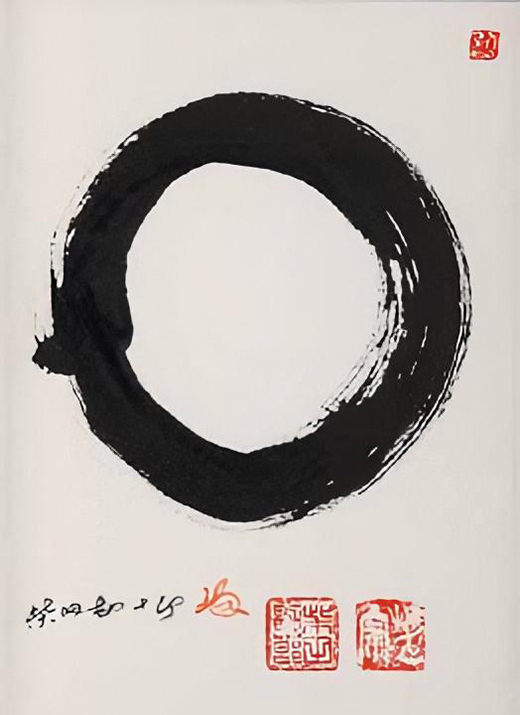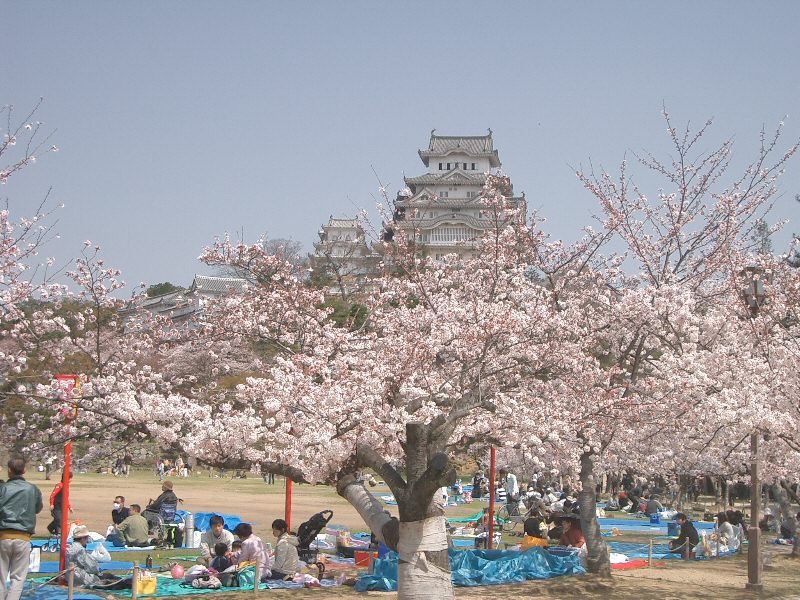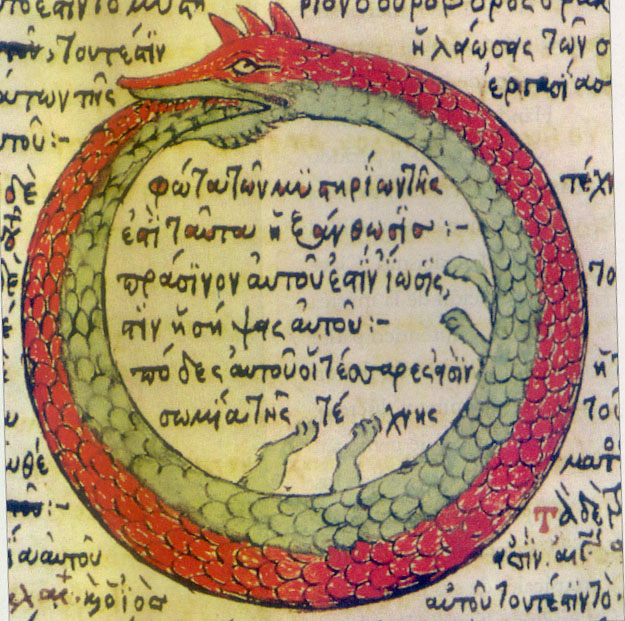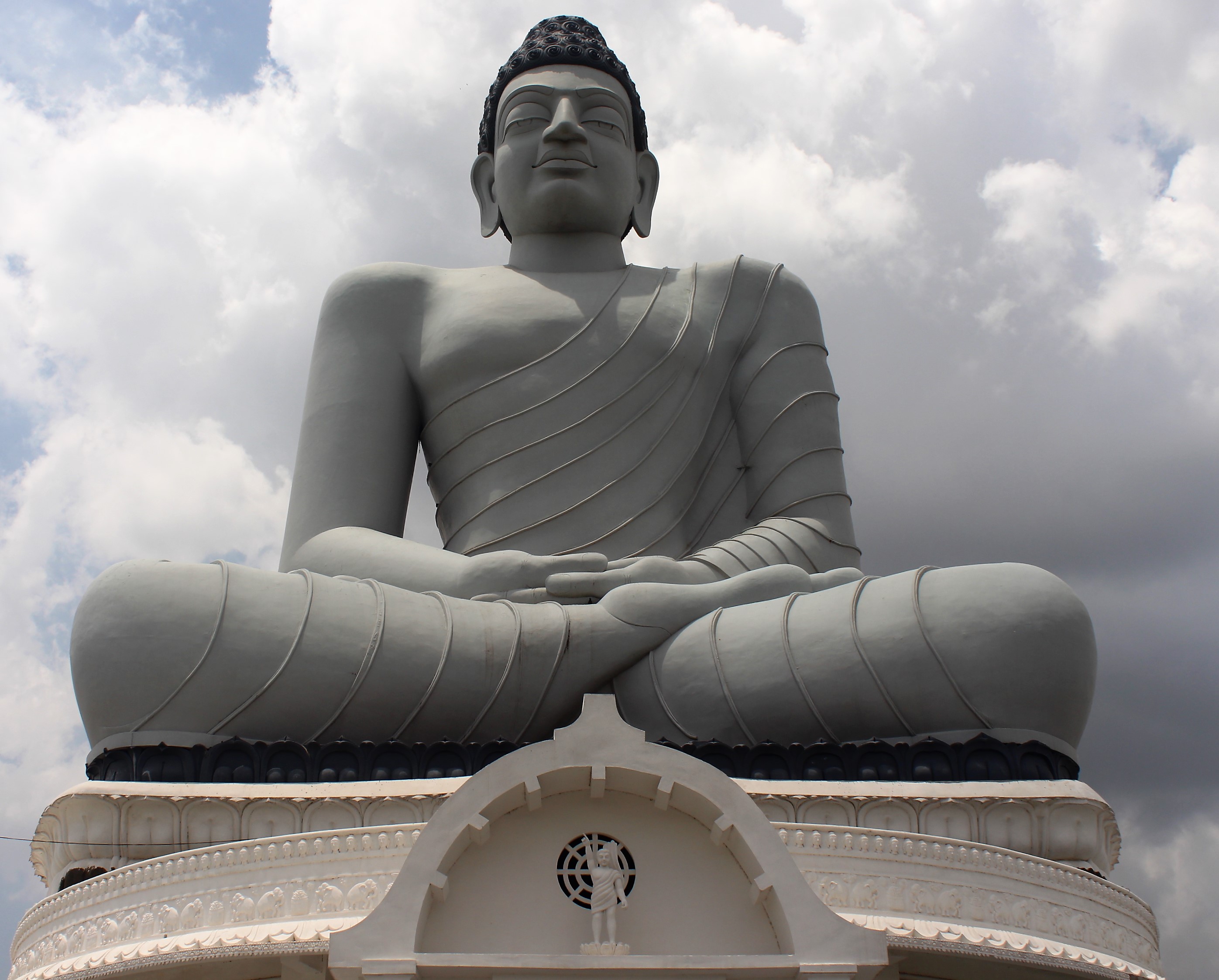|
Ensō
In Zen, an is a circle that is hand-drawn in one or two uninhibited brushstrokes to express a moment when the mind is free to let the body create. Description The symbolizes absolute enlightenment, strength, elegance, the universe, and (the void). It is characterised by a minimalism born of Japanese aesthetics. Drawing is a disciplined-creative practice of Japanese ink painting, . The tools and mechanics of drawing the are the same as those used in traditional Japanese calligraphy: One uses an ink brush to apply ink to (a thin Japanese paper). The circle may be open or closed. In the former case, the circle is incomplete, allowing for movement and development as well as the perfection of all things. Zen practitioners relate the idea to , the beauty of imperfection. When the circle is closed, it represents perfection, akin to Plato's perfect form, the reason why the circle was used for centuries in the construction of cosmological models (see Ptolemy). Usually, a person ... [...More Info...] [...Related Items...] OR: [Wikipedia] [Google] [Baidu] |
Japanese Aesthetics
Japanese aesthetics comprise a set of ancient ideals that include '' wabi'' (transient and stark beauty), '' sabi'' (the beauty of natural patina and aging), and '' yūgen'' (profound grace and subtlety). These ideals, and others, underpin much of Japanese cultural and aesthetic norms on what is considered tasteful or beautiful. Thus, while seen as a philosophy in Western societies, the concept of aesthetics in Japan is seen as an integral part of daily life. Japanese aesthetics now encompass a variety of ideals; some of these are traditional while others are modern and sometimes influenced by other cultures. Shinto and Buddhism Shinto is considered to be at the fountain-head of Japanese culture. With its emphasis on the wholeness of nature and character in ethics, and its celebration of the landscape, it sets the tone for Japanese aesthetics. Until the thirteenth century, Shinto remained the main influence on Japanese aesthetics. In the Buddhist tradition, all things are cons ... [...More Info...] [...Related Items...] OR: [Wikipedia] [Google] [Baidu] |
Ouroboros
The ouroboros or uroboros () is an ancient symbol depicting a serpent or dragon eating its own tail. The ouroboros entered Western tradition via ancient Egyptian iconography and the Greek magical tradition. It was adopted as a symbol in Gnosticism and Hermeticism and most notably in alchemy. The term derives , from ''oura'' 'tail' plus ''-boros'' '-eating'. The ''ouroboros'' is often interpreted as a symbol for eternal cyclic renewal or a cycle of life, death, and rebirth; the snake’s skin-sloughing symbolizes the transmigration of souls. The snake biting its own tail is a fertility symbol in some religions: the tail is a phallic symbol and the mouth is a yonic or womb-like symbol. Some snakes, such as rat snakes, have been known to consume themselves. One captive snake attempted to consume itself twice, dying in the second attempt. Another wild rat snake was found having swallowed about two-thirds of its body. Historical representations Ancient Egypt One of the e ... [...More Info...] [...Related Items...] OR: [Wikipedia] [Google] [Baidu] |
Hitsuzendō
is believed by Zen Buddhists to be a method of achieving samādhi (Japanese: 三昧 ''sanmai''), which is a unification with the highest reality. Hitsuzendo refers specifically to a school of Japanese Zen calligraphy to which the rating system of modern calligraphy (well-proportioned and pleasing to the eye) is foreign. Instead, the calligraphy of Hitsuzendo must breathe with the vitality of eternal experience. Origins Yokoyama Tenkei (1885–1966), inspired by the teachings of Yamaoka Tesshu (1836–1888), founded the Hitsuzendo line of thought as a "practice to uncover one's original self through the brush." This was then further developed by Omori Sogen Roshi as a way of Zen practice. Hitsuzendo is practised standing, using a large brush and ink, usually on newspaper roll. In this way, the whole body is used to guide the brush, in contrast to writing at a table. History Calligraphy was brought to Japan from China and Chinese masters such as Wang Xizhi 王羲之 (Jp: Ou ... [...More Info...] [...Related Items...] OR: [Wikipedia] [Google] [Baidu] |
Weatherhill
Shambhala Publications is an independent publishing company based in Boulder, Colorado. According to the company, it specializes in "books that present creative and conscious ways of transforming the individual, the society, and the planet". Many of its titles deal with Buddhism and related topics in religion and philosophy. The company's name was inspired by the Sanskrit word Shambhala, referring to a mystical kingdom hidden beyond the snowpeaks of the Himalayas, according to the Tibetan Buddhist tradition. Its authors include Chögyam Trungpa, Pema Chödrön, Thomas Cleary, Ken Wilber, Fritjof Capra, A. H. Almaas, John Daido Loori, John Stevens, Edward Espe Brown and Natalie Goldberg. The company is unaffiliated with Shambhala Buddhism, Shambhala International, or '' Lion's Roar'' (previously entitled ''Shambhala Sun'') magazine. History Shambhala was founded in 1969 by Samuel Bercholz and Michael Fagan, in Berkeley, California. Its books are distributed by Penguin Random H ... [...More Info...] [...Related Items...] OR: [Wikipedia] [Google] [Baidu] |
Ink Wash Painting
Ink wash painting ( zh, t=水墨畫, s=水墨画, p=shuǐmòhuà; ja, 水墨画, translit=suiboku-ga or ja, 墨絵, translit=sumi-e; ko, 수묵화, translit=sumukhwa) is a type of Chinese ink brush painting which uses black ink, such as that used in Asian calligraphy, in different concentrations. It emerged during the Tang dynasty of China (618–907); it overturned earlier, more realistic techniques. It is typically monochrome, using only shades of black, with a great emphasis on virtuoso brushwork and conveying the perceived "spirit" or "essence" of a subject over direct imitation. Ink wash painting flourished from the Song dynasty in China (960–1279) onwards, as well as in Japan after it was introduced by Zen Buddhist monks in the 14th century. Some Western scholars divide Chinese painting (including ink wash painting) into three periods: times of representation, times of expression, and historical Oriental art. Chinese scholars have their own views which may be diffe ... [...More Info...] [...Related Items...] OR: [Wikipedia] [Google] [Baidu] |
Dhyāna In Buddhism
In the oldest texts of Buddhism, ''dhyāna'' () or ''jhāna'' () is a component of the training of the mind (''bhavana''), commonly translated as meditation, to withdraw the mind from the automatic responses to sense-impressions, "burn up" the defilements, and leading to a "state of perfect equanimity and awareness ('' upekkhā-sati- parisuddhi'')." ''Dhyāna'' may have been the core practice of pre-sectarian Buddhism, in combination with several related practices which together lead to perfected mindfulness and detachment. In the later commentarial tradition, which has survived in present-day Theravāda, ''dhyāna'' is equated with "concentration", a state of one-pointed absorption in which there is a diminished awareness of the surroundings. In the contemporary Theravāda-based Vipassana movement, this absorbed state of mind is regarded as unnecessary and even non-beneficial for the first stage of awakening, which has to be reached by mindfulness of the body and ''vipassan ... [...More Info...] [...Related Items...] OR: [Wikipedia] [Google] [Baidu] |
Buddhism In Japan
Buddhism has been practiced in Japan since about the 6th century CE. Japanese Buddhism () created many new Buddhist schools, and some schools are original to Japan and some are derived from Chinese Buddhist schools. Japanese Buddhism has had a major influence on Japanese society and culture and remains an influential aspect to this day.Asia SocietBuddhism in Japan accessed July 2012 According to the Japanese Government's Agency for Cultural Affairs estimate, , with about 84 million or about 67% of the Japanese population, Buddhism was the religion in Japan with the second most adherents, next to Shinto, though a large number of people practice elements of both. According to the statistics by the Agency for Cultural Affairs in 2021, the religious corporation under the jurisdiction of the Ministry of Education, Culture, Sports, Science and Technology in Japan had 135 million believers, of which 47 million were Buddhists and most of them were believers of new schools of Buddhism ... [...More Info...] [...Related Items...] OR: [Wikipedia] [Google] [Baidu] |
Abstract Expressionism
Abstract expressionism is a post–World War II art movement in American painting, developed in New York City in the 1940s. It was the first specifically American movement to achieve international influence and put New York at the center of the Western art world, a role formerly filled by Art in Paris, Paris. Although the term "abstract expressionism" was first applied to American art in 1946 by the art critic Robert Coates (critic), Robert Coates, it had been first used in Germany in 1919 in the magazine ''Der Sturm'', regarding German Expressionism. In the United States, Alfred Barr was the first to use this term in 1929 in relation to works by Wassily Kandinsky. Style Technically, an important predecessor is surrealism, with its emphasis on spontaneous, Surrealist automatism, automatic, or subconscious creation. Jackson Pollock's dripping paint onto a canvas laid on the floor is a technique that has its roots in the work of André Masson, Max Ernst, and David Alfaro Siqu ... [...More Info...] [...Related Items...] OR: [Wikipedia] [Google] [Baidu] |
Wuji (philosophy)
In Chinese philosophy, ''wújí'' (, meaning 'without limit') originally referred to infinity but came to mean the "primordial universe" prior to the "Supreme Ultimate" state of being ( ''Taiji'', ) in the Neo-Confucianist cosmology of Song China. '' Wuji'' is also a proper noun in Modern Standard Chinese usage; for instance, Wuji County in Hebei. The word ''Wuji'' Chinese ''wuji'' "limitless; infinite" is a compound of the nothingness concept of wu and ''ji'' (ridgepole > limit, extremity, utmost). In analogy with the figurative meanings of English ', Chinese ''ji'' "ridgepole" can mean "geographical pole; direction" (e.g., ''siji'' "four corners of the earth; world's end"), " magnetic pole" ''Beiji'' "North Pole", ''Nanji'' "South Pole", ''yangji'' "positive pole; anode" ''yinji'' "negative pole; cathode"), (''baji'' "farthest points of the universe; remotest place"). Common English translations of the cosmological ''Wuji'' are "Ultimateless" (Fung and Bodde 195 ... [...More Info...] [...Related Items...] OR: [Wikipedia] [Google] [Baidu] |
Time Warner
Warner Media, LLC ( traded as WarnerMedia) was an American multinational mass media and entertainment conglomerate. It was headquartered at the 30 Hudson Yards complex in New York City, United States. It was originally established in 1972 by Steve Ross as Warner Communications, and Time Warner was created in 1990, following a merger between Time Inc. and the original Warner Communications. The company has film, television and cable operations, with its assets including WarnerMedia Studios & Networks (consisting of the entertainment assets of Turner Broadcasting, HBO, and Cinemax as well as Warner Bros., which itself consists of the film, animation, television studios, the company's home entertainment division and Studio Distribution Services, its joint venture with Universal Pictures Home Entertainment, DC Comics, New Line Cinema, and, together with CBS Entertainment Group, through its Warner Bros. Entertainment subsidiary, a 50% interest in The CW television network); Warne ... [...More Info...] [...Related Items...] OR: [Wikipedia] [Google] [Baidu] |
CNNMoney
CNN Business (formerly CNN Money) is a financial news and information website, operated by CNN. The website was originally formed as a joint venture between CNN.com and Time Warner's ''Fortune'' and ''Money'' magazines. Since the spin-off of Time Warner's publishing assets as Time Inc. (and their subsequent sale to Meredith Corporation and later, to IAC's Dotdash), the site has since operated as an affiliate of CNN. History CNN Money launched in 2001, replacing CNNfn's website. Time Warner had also announced an intention to relaunch the CNNfn television network under the CNN Money moniker, but those plans were apparently scrapped. Prior to June 2014, the website was operated as a joint venture between CNN and two Time Warner-published business magazines; ''Fortune'' and ''Money''. In June 2014, Time Warner's publishing assets were spun-out as Time Inc.; as a result, all three properties launched separate web presences, and CNN Money introduced a new logo that removed the wordma ... [...More Info...] [...Related Items...] OR: [Wikipedia] [Google] [Baidu] |
American Institute Of Graphic Arts
The American Institute of Graphic Arts (AIGA) is a professional organization for design. Its members practice all forms of communication design, including graphic design, typography, interaction design, user experience, branding and identity. The organization's aim is to be the standard bearer for professional ethics and practices for the design profession. There are currently over 25,000 members and 72 chapters, and more than 200 student groups around the United States. In 2005, AIGA changed its name to “AIGA, the professional association for design,” dropping the "American Institute of Graphic Arts" to welcome all design disciplines. AIGA aims to further design disciplines as professions, as well as cultural assets. As a whole, AIGA offers opportunities in exchange for creative new ideas, scholarly research, critical analysis, and education advancement. History In 1911, Frederic Goudy, Alfred Stieglitz, and W. A. Dwiggins came together to discuss the creation of an orga ... [...More Info...] [...Related Items...] OR: [Wikipedia] [Google] [Baidu] |




